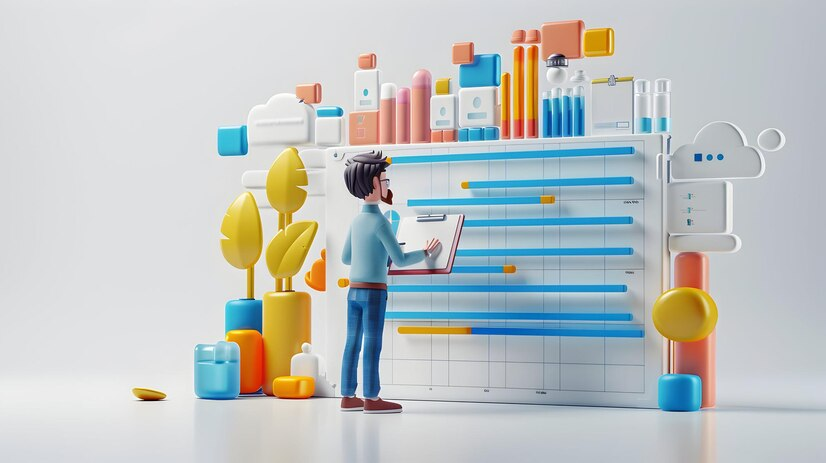In recent years, 3D animation has revolutionized the field of scientific visualization, enabling researchers and educators to present complex data in an accessible and engaging manner. By transforming abstract concepts into tangible visuals, 3D animation enhances understanding and communication across various scientific disciplines. This blog explores the significant role of 3D animation in scientific visualization, the technologies driving this transformation, and the unique benefits it offers.
The Power of 3D Animation in Scientific Visualization
Scientific visualization involves the representation of data or concepts through graphical means, helping to make sense of complex information. Traditionally, this has been achieved through static images, graphs, and charts. However, with the advent of 3D animation, scientists can now create dynamic and interactive visualizations that provide a deeper and more intuitive understanding of their data.
Enhancing Data Interpretation
One of the primary benefits of 3D animation in scientific visualization is its ability to enhance data interpretation. By animating data, researchers can observe patterns, trends, and anomalies that may not be evident in static representations. For example, in meteorology, 3D animations of weather patterns can reveal the movement and interaction of atmospheric systems, offering insights that static maps cannot.
Communicating Complex Concepts
3D animation excels in communicating complex scientific concepts to diverse audiences. Whether explaining the intricacies of molecular biology, the dynamics of black holes, or the mechanisms of climate change, 3D animations make abstract ideas more concrete. This is particularly valuable in education, where visual aids can significantly improve comprehension and retention.
Facilitating Collaboration
In scientific research, collaboration is crucial. 3D animation facilitates collaboration by providing a common visual language that researchers from different disciplines can understand. This visual language transcends linguistic and cultural barriers, fostering more effective communication and cooperation among scientists worldwide.
Technologies Driving 3D Animation in Scientific Visualization
The advancements in 3D animation for scientific visualization are driven by several key technologies, including powerful software, sophisticated hardware, and innovative platforms like Unreal Engine.
3D Animation Software
Several software packages are specifically designed for creating scientific visualizations. These include Autodesk Maya, Blender, and Cinema 4D. These tools offer advanced modeling, rendering, and animation capabilities, allowing scientists to create highly detailed and accurate visualizations.
Virtual Reality (VR) and Augmented Reality (AR)
VR and AR technologies have taken 3D animation to new heights. VR immerses users in a fully interactive 3D environment, while AR overlays digital information onto the real world. In scientific visualization, VR can simulate environments like the deep ocean or outer space, providing researchers with a unique perspective. AR, on the other hand, can enhance real-world observations with additional data, such as highlighting geological features during field studies.
Unreal Engine
Unreal Engine, a popular game development platform, has found a significant place in scientific visualization. Known for its high-fidelity graphics and real-time rendering capabilities, Unreal engine games allows scientists to create interactive and immersive visualizations. This platform is particularly useful for creating simulations and virtual environments that can be explored in real-time, offering a deeper understanding of complex phenomena.
Applications of 3D Animation in Scientific Visualization
The applications of 3D animation in scientific visualization are vast and varied. Here, we explore some key areas where 3D animation is making a significant impact.
Medicine and Biology
In medicine and biology, 3D animation is used to visualize the structures and functions of the human body at a cellular and molecular level. For instance, animations of cellular processes, such as DNA replication or protein synthesis, provide a clear understanding of these intricate mechanisms. Additionally, 3D animations of surgical procedures help train medical professionals by offering a realistic view of the human anatomy and surgical techniques.
Astronomy and Astrophysics
Astronomy and astrophysics benefit greatly from 3D animation, which can illustrate the vastness and complexity of the universe. Animations of celestial bodies, such as planets, stars, and galaxies, help scientists study their formation, movement, and interaction. Furthermore, 3D simulations of cosmic events, like supernovae or black hole collisions, provide valuable insights into these phenomena.
Environmental Science
Environmental science uses 3D animation to visualize ecological systems and environmental changes. For example, animations of climate models can show the effects of global warming on polar ice caps, sea levels, and weather patterns. These visualizations help researchers, policymakers, and the public understand the urgency of addressing environmental issues.
Engineering and Architecture
In engineering and architecture, 3D animation aids in the design and analysis of structures and systems. Engineers use animations to visualize stress tests on materials, simulate fluid dynamics, and model complex machinery. Architects use 3D animations to create realistic representations of buildings and urban environments, allowing for better planning and design.
Benefits of 3D Animation in Scientific Visualization
The integration of 3D animation in scientific visualization offers numerous benefits, making it an indispensable tool in modern science.
Improved Understanding
3D animations break down complex data into manageable and comprehensible visual forms. This improved understanding is crucial for both researchers and the public, as it enhances knowledge dissemination and promotes scientific literacy.
Increased Engagement
Interactive and visually appealing 3D animations capture attention and increase engagement. This is particularly beneficial in educational settings, where engaging visual aids can inspire interest and curiosity in scientific subjects.
Enhanced Communication
3D animations serve as a universal language, bridging gaps between different scientific disciplines and between scientists and the public. This enhanced communication fosters collaboration and drives scientific progress.
Real-Time Interaction
With platforms like Unreal Engine, scientists can interact with their visualizations in real-time. This interactivity allows for immediate exploration and manipulation of data, leading to quicker insights and discoveries.
The Role of 3D Animation Services
The growing demand for high-quality scientific visualizations has led to the emergence of specialized 3D animation services. These services provide expertise and resources to create accurate and visually stunning animations tailored to scientific needs.
Custom Solutions
3D animation services offer custom solutions tailored to specific scientific requirements. Whether it’s a detailed molecular animation or a large-scale environmental simulation, these services ensure that the visualizations are both scientifically accurate and visually compelling.
Collaboration with Experts
3D animation services often collaborate with scientific experts to ensure the accuracy of the visualizations. This collaboration ensures that the animations are not only visually appealing but also grounded in scientific reality.
Advanced Technology
These services utilize the latest technology and software, including Unreal Engine, to create high-quality animations. This ensures that the visualizations are up-to-date with the latest advancements in 3D animation technology.
The Future of 3D Animation in Scientific Visualization
The future of 3D animation in scientific visualization looks promising, with continuous advancements in technology and increasing adoption across various scientific fields.
Artificial Intelligence (AI)
AI is set to play a significant role in the future of 3D animation. AI algorithms can automate the creation of complex animations, analyze large datasets, and generate real-time insights. This will further enhance the capabilities of 3D animation in scientific visualization.
Increased Accessibility
As technology becomes more affordable and user-friendly, 3D animation will become more accessible to scientists and educators. This democratization of technology will enable more researchers to leverage 3D animation for their work, leading to a broader and more diverse range of scientific visualizations.
Virtual and Augmented Reality
The integration of VR and AR with 3D animation will continue to grow, offering more immersive and interactive experiences. These technologies will enable scientists to explore virtual environments and conduct experiments in ways that were previously unimaginable.
Cross-Disciplinary Applications
The use of 3D animation will expand across different scientific disciplines, fostering cross-disciplinary collaboration and innovation. By providing a common visual language, 3D animation will facilitate the exchange of ideas and knowledge between various fields of study.
Conclusion
3D animation has revolutionized scientific visualization, offering a powerful tool for enhancing data interpretation, communication, and collaboration. The integration of advanced technologies, such as Unreal Engine, has further elevated the capabilities of 3D animation, providing real-time interactivity and high-fidelity graphics. As the field continues to evolve, the role of 3D animation services will be crucial in providing the expertise and resources needed to create accurate and visually stunning scientific visualizations.
In the future, advancements in AI, increased accessibility, and the integration of VR and AR will further enhance the potential of 3D animation in scientific visualization. By bringing data to life, 3D animation will continue to drive scientific discovery, education, and communication, making it an indispensable tool in the pursuit of knowledge.


